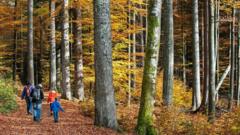Can Certain Tree Species Save UK Forests from Rising Temperatures?

Published: 2025-10-19 05:00:48 | Category: technology
As climate change continues to impact ecosystems worldwide, the United Kingdom's trees face unprecedented challenges. A recent initiative by Forestry England has introduced a 'species for the future' list, identifying thirty tree species likely to thrive in a warming climate. This strategic move aims to bolster forest resilience amid increasing extreme weather patterns. Familiar species like oak and birch are included, alongside newcomers like coast redwood and Corsican pine, which could help sustain biodiversity in the UK’s shifting environment.
Last updated: 13 October 2023 (BST)
Key Takeaways
- Forestry England's 'species for the future' list highlights thirty tree species expected to thrive in a warmer climate.
- Traditional species such as oak are under threat from diseases like acute oak decline, exacerbated by climate change.
- Assisted migration is being considered as a strategy to introduce species better suited to future conditions.
- Extreme weather events are increasing in frequency, making it harder for trees to adapt.
- Balancing conservation efforts with the risks of introducing non-native species is crucial.
The Impact of Climate Change on UK Trees
As temperatures rise and weather patterns become more erratic, the UK's trees are under significant stress. Dr Eleanor Tew from Forestry England has expressed concern over the changing conditions that threaten these vital ecosystems. In recent years, record heatwaves have resulted in the death of numerous trees, signalling that the natural world is struggling to adapt to the rapid shifts brought about by climate change.
Recent Trends and Observations
The summer of 2022 was particularly devastating, with reports indicating that 460 trees died at the Royal Botanical Gardens, Kew, due to the intense heat. Kevin Masters, Head of Tree Collections at Kew, has noted that the frequency of such events is increasing, with occurrences that would have been rare now becoming commonplace every few years. This alarming trend highlights the urgency of addressing climate-related threats to forestry.
Understanding the 'Species for the Future' List
Forestry England's newly released list serves as an important tool in future-proofing the nation's forests. The list comprises a diverse range of trees, both native and non-native, that are expected to cope better with rising temperatures, changing rainfall patterns, and the emergence of new pests and diseases. This inventory aims to foster stronger, more adaptable woodlands, ensuring that the ecological balance of the UK is maintained even as climate conditions evolve.
Familiar and Uncommon Species
Included in the list are well-known trees such as oak, birch, and alder. However, it also features less familiar species like the coast redwood, native to North America, and the Corsican pine from the Mediterranean. These selections reflect a growing interest in assisted migration, which involves planting tree species that can thrive in the expected climate conditions of the future.
Historical Context of Tree Adaptation
The Earth's climate has historically cycled through glacial and interglacial periods over thousands of years. Trees have typically adapted through migration, with seedlings moving southward during colder periods and northward as temperatures rose. However, the current rate of climate change, driven primarily by human activity, has resulted in a rapid 1.3°C rise in just the last century—ten times faster than historical rates. This leaves trees struggling to keep pace with the changes.
Current Challenges for Tree Seedlings
According to Dr Sarah Dalrymple, a plant ecologist at Liverpool John Moores University, there are already observable changes affecting tree seedlings. Many seedlings are failing to fertilise and disperse into suitable habitats, largely due to increasingly dry conditions. The oak tree, which constitutes about 20% of the UK's broadleaf tree species, is facing decline due to acute oak decline—a disease linked to heat and drought stress.
The Importance of Oak Trees
Oaks are vital to the UK's ecosystem, supporting an estimated 2,300 species of wildlife, including various birds, mammals, fungi, and insects. The decline of oak trees poses a significant threat to biodiversity, as it would disrupt the habitats of numerous species that rely on oaks for food and shelter.
Assisted Migration: A Solution or a Risk?
The concept of assisted migration is garnering interest among conservationists. This approach suggests introducing tree species currently thriving in warmer regions, like the common oak from Georgia and Azerbaijan, which could adapt well to southern England's future climate. However, this strategy is not without its challenges. The unpredictable weather patterns in the UK, such as late spring frosts followed by heatwaves, complicate the adaptation process for trees.
The Risks of Non-native Species
Introducing non-native species carries its own set of risks. For instance, the introduction of a wind-borne fungus from Asia in 2012 led to ash dieback, threatening up to 80% of mature ash trees in the UK. The consequences of such diseases can be severe, impacting not just the trees but the broader ecosystem and economy as well.
Striking a Balance
Mr Masters from Kew Gardens points out the importance of conservation efforts. Allowing nature to take its course without intervention may result in the loss of oak trees and the biodiversity they support. Conversely, selecting species better suited to future climates necessitates careful consideration of their potential invasiveness and ecological impact. Dr Tew emphasises that there is no single solution, and a diversity of strategies is essential for helping trees adapt to changing conditions.
Looking Ahead: The Future of British Forests
As we dive deeper into autumn, the vibrant colours of the season remind us of nature's beauty. However, the challenges posed by climate change require immediate action to safeguard the future of British forests. The 'species for the future' initiative is a proactive step towards ensuring that our woodlands remain resilient and diverse amid shifting climatic conditions.
Conclusion: What Lies Ahead?
The fate of the UK's forests hangs in the balance as we confront the realities of climate change. The ongoing challenge is to implement effective conservation strategies while remaining vigilant about potential risks. The question remains: how can we balance intervention with the natural course of ecosystems to preserve biodiversity for future generations? As the climate continues to evolve, the answers may shape the landscapes of tomorrow.
FAQs
What is the 'species for the future' list?
The 'species for the future' list is a compilation of thirty tree species identified by Forestry England that are expected to thrive in a warming climate, including both native and non-native varieties.
Why are oak trees important to the ecosystem?
Oak trees support approximately 2,300 species of wildlife, making them crucial for biodiversity. They provide habitat and food for various birds, mammals, fungi, and insects.
What is assisted migration in forestry?
Assisted migration involves introducing tree species that are currently thriving in warmer regions into areas where they may be better suited to future climate conditions, helping to sustain forests.
What are the risks of introducing non-native species?
Introducing non-native species can lead to ecological imbalances, including the potential for invasive species to outcompete native flora and contribute to the decline of local biodiversity.
How has climate change affected tree seedlings?
Climate change has resulted in conditions that hinder tree seedlings from fertilising and dispersing into suitable habitats, often due to increased dryness and heat stress.
What are the consequences of oak decline?
Oak decline can lead to significant biodiversity loss, as these trees support a wide range of wildlife. Their decline threatens the habitats and food sources for many species.



